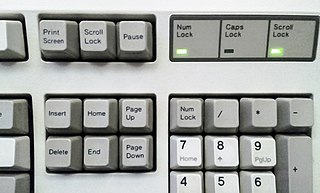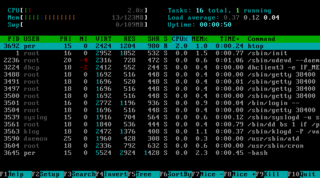
ASCII, an acronym for American Standard Code for Information Interchange, is a character encoding standard for electronic communication. ASCII codes represent text in computers, telecommunications equipment, and other devices. ASCII has just 128 code points, of which only 95 are printable characters, which severely limit its scope. The set of available punctuation had significant impact on the syntax of computer languages and text markup. ASCII hugely influenced the design of character sets used by modern computers, including Unicode which has over a million code points, but the first 128 of these are the same as ASCII.

ASCII art is a graphic design technique that uses computers for presentation and consists of pictures pieced together from the 95 printable characters defined by the ASCII Standard from 1963 and ASCII compliant character sets with proprietary extended characters. The term is also loosely used to refer to text-based visual art in general. ASCII art can be created with any text editor, and is often used with free-form languages. Most examples of ASCII art require a fixed-width font such as Courier for presentation.
In computing and telecommunications, a control character or non-printing character (NPC) is a code point in a character set that does not represent a written character or symbol. They are used as in-band signaling to cause effects other than the addition of a symbol to the text. All other characters are mainly graphic characters, also known as printing characters, except perhaps for "space" characters. In the ASCII standard there are 33 control characters, such as code 7, BEL, which rings a terminal bell.

Scroll Lock is a lock key on most IBM-compatible computer keyboards. Depending on the operating system, it may be used for different purposes, and applications may assign functions to the key or change their behavior depending on its toggling state. The key is not frequently used, and therefore some reduced or specialized keyboards lack Scroll Lock altogether.

ANSI escape sequences are a standard for in-band signaling to control cursor location, color, font styling, and other options on video text terminals and terminal emulators. Certain sequences of bytes, most starting with an ASCII escape character and a bracket character, are embedded into text. The terminal interprets these sequences as commands, rather than text to display verbatim.
A text file is a kind of computer file that is structured as a sequence of lines of electronic text. A text file exists stored as data within a computer file system.

A newline is a control character or sequence of control characters in character encoding specifications such as ASCII, EBCDIC, Unicode, etc. This character, or a sequence of characters, is used to signify the end of a line of text and the start of a new one.
The null character is a control character with the value zero. It is present in many character sets, including those defined by the Baudot and ITA2 codes, ISO/IEC 646, the C0 control code, the Universal Coded Character Set, and EBCDIC. It is available in nearly all mainstream programming languages. It is often abbreviated as NUL. In 8-bit codes, it is known as a null byte.
In computing, end-of-file (EOF) is a condition in a computer operating system where no more data can be read from a data source. The data source is usually called a file or stream.
uuencoding is a form of binary-to-text encoding that originated in the Unix programs uuencode and uudecode written by Mary Ann Horton at the University of California, Berkeley in 1980, for encoding binary data for transmission in email systems.
A bell character is a device control code originally sent to ring a small electromechanical bell on tickers and other teleprinters and teletypewriters to alert operators at the other end of the line, often of an incoming message. Though tickers punched the bell codes into their tapes, printers generally do not print a character when the bell code is received. Bell codes are usually represented by the label "BEL". They have been used since 1870.
Caret notation is a notation for control characters in ASCII. The notation assigns ^A to control-code 1, sequentially through the alphabet to ^Z assigned to control-code 26 (0x1A). For the control-codes outside of the range 1–26, the notation extends to the adjacent, non-alphabetic ASCII characters.
The C0 and C1 control code or control character sets define control codes for use in text by computer systems that use ASCII and derivatives of ASCII. The codes represent additional information about the text, such as the position of a cursor, an instruction to start a new line, or a message that the text has been received.
tail is a program available on Unix, Unix-like systems, FreeDOS and MSX-DOS used to display the tail end of a text file or piped data.
In computer data, a substitute character (␚) is a control character that is used to pad transmitted data in order to send it in blocks of fixed size, or to stand in place of a character that is recognized to be invalid, erroneous or unrepresentable on a given device. It is also used as an escape sequence in some programming languages.
Binary Synchronous Communication is an IBM character-oriented, half-duplex link protocol, announced in 1967 after the introduction of System/360. It replaced the synchronous transmit-receive (STR) protocol used with second generation computers. The intent was that common link management rules could be used with three different character encodings for messages.
On personal computers with numeric keypads that use Microsoft operating systems, such as Windows, many characters that do not have a dedicated key combination on the keyboard may nevertheless be entered using the Alt code. This is done by pressing and holding the Alt key, then typing a number on the keyboard's numeric keypad that identifies the character and then releasing Alt.
The delete control character is the last character in the ASCII repertoire, with the code 127. It is supposed to do nothing and was designed to erase incorrect characters on paper tape. It is denoted as ^? in caret notation and is U+007F in Unicode.

cat is a standard Unix utility that reads files sequentially, writing them to standard output. The name is derived from its function to (con)catenate files . It has been ported to a number of operating systems.





